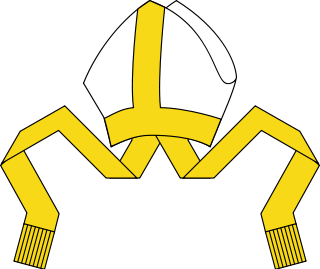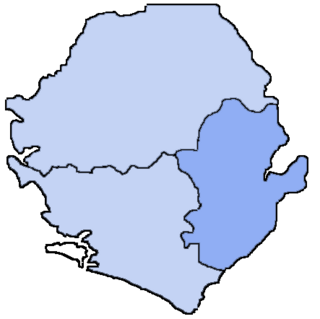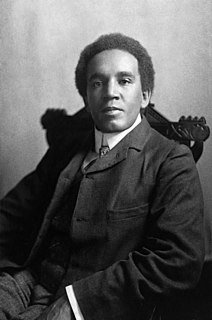
Freetown is the capital and largest city of Sierra Leone. It is a major port city on the Atlantic Ocean and is located in the Western Area of the country. Freetown is Sierra Leone's major urban, economic, financial, cultural, educational and political centre, as it is the seat of the Government of Sierra Leone. The population of Freetown was 1,055,964 at the 2015 census.

Bo, also commonly referred to as Bo Town, is the second largest city in Sierra Leone by landscape/geographical location and the largest city in the Southern Province. Bo is the capital and administrative centre of Bo District. The city of Bo had a population of 149,957 in the 2004 census and had a population of about 233,684 based on 2017 estimate. Bo is an urban centre, and lies approximately 160 miles (250 km) eastsoutheast of Freetown, and about 40 miles (71 km) to Kenema. Bo is the leading financial, educational and economic centre of southern Sierra Leone.
The Archdiocese of Freetown is a Roman Catholic diocese in Sierra Leone. It is centred on the city of Freetown, the capital and most populous city of the African country of Sierra Leone.

The Most Reverend Joseph Henry Ganda, Archbishop Emeritus, is the retired Archbishop of the Archdiocese of Freetown and Bo.

The Catholic Church in Sierra Leone is part of the worldwide Catholic Church, under the spiritual leadership of the Pope in Rome.

The University of Sierra Leone is the name of the former unitary public university system in Sierra Leone. Established in February 1827, it is the oldest university in Africa.
Articles related to Sierra Leone include:

The Roman Catholic Metropolitan Archdiocese of Perth is a Latin Church metropolitan archdiocese of the Catholic Church in Australia covering the Greater Perth, Goldfields-Esperance, Peel and Wheatbelt regions of Western Australia.
Lamina Sankoh, born as Etheldred Nathaniel Jones, was a Sierra Leonean pre-independence politician, educator, banker and cleric. Sankoh is known most prominently for helping to found the Peoples Party in 1948, one of the first political parties in Sierra Leone. It eventually became the Sierra Leone People's Party.
Saint Edward's Primary School is an all-boys primary (elementary) school currently located at Fort Street in Freetown, Sierra Leone. Typically, it enrolls boys from ages 3 to 12. Its sister school is St. Joseph's Primary School.

Mass media in Sierra Leone began when the first modern printing press in Africa arrived at the start of the 19th century. In the 1860s the country became a journalist hub for Africa with professional travelling to the country from across the continent. At the end of the 19th century the industry went into decline and when radio was introduced in the 1930s this became the primary communication media. Print media is not widely read in Sierra Leone, especially outside Freetown, partially due to the low levels of literacy in the country. In 2008 there were 15 daily newspapers in addition to those published weekly. Among newspaper readership young people are likely to read newspapers weekly and older people daily. The majority of newspapers are privately run and are often critical of the government.

The Roman Catholic Archdiocese of Lagos {Lagosen(sis) in Latin} is the Metropolitan See for the Ecclesiastical province of Lagos in Nigeria.

The Roman Catholic Diocese of Kenema is a diocese Catholic Church in the Ecclesiastical province of Freetown in Sierra Leone. The region that the Diocese comprises are the border from Bo District to the west, the Republic of Liberia in the southeast, Tonkolili District and Kono District in the north, Guinea in the east.
The Inter-territorial Catholic Bishops' Conference of The Gambia and Sierra Leone (ITCABIC) is the episcopal conference of the Catholic Church in the Sierra Leone and The Gambia.
The following is a timeline of the history of the city of Freetown, Sierra Leone.

The Sierra Leone Creole people are an ethnic group of Sierra Leone. The Sierra Leone Creole people are descendants of freed African American, Afro-Caribbean, and Liberated African slaves who settled in the Western Area of Sierra Leone between 1787 and about 1885. The colony was established by the British, supported by abolitionists, under the Sierra Leone Company as a place for freedmen. The settlers called their new settlement Freetown. Today, the Sierra Leone Creoles are 1.3% of the population of Sierra Leone.
The Immaculate Heart of Mary Cathedral also simply called Cathedral of Bo, is a religious building belonging to the Catholic Church, and is located in the town of Bo the second largest in population and of the Southern Province, in the African country of Sierra Leone.

Patrick Daniel Koroma, C.S.Sp., MOR was the bishop of the Catholic Church in Kenema, Sierra Leone.
Bishop Ambrose Kelly C.S.Sp was a member of the Holy Ghost Fathers, and served as Archbishop of Freetown and Bo, in Sierre Leone.











